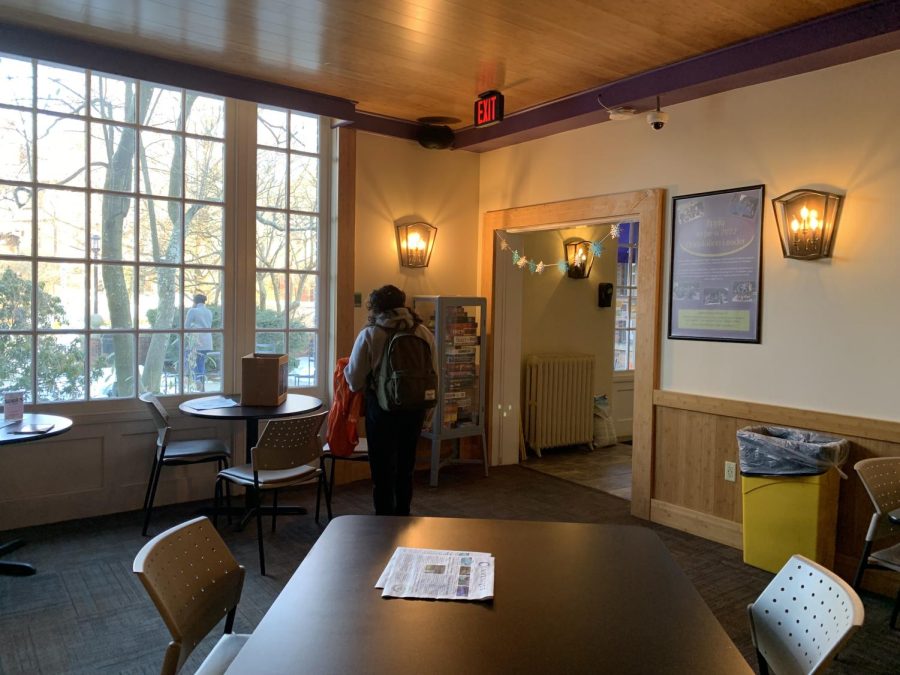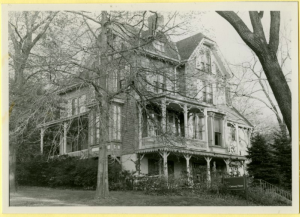Chatham’s campus feels increasingly cramped (before and during COVID-19)
A student stands in the Carriage House lounge, one of the indoor common areas on Chatham’s Shadyside campus. Photo Credit: Abbey Sullivan
February 16, 2022
Social distancing was one of the first measures implemented during the rise of COVID-19. To this day, it remains a means for preventing dangerous viral spread by mitigating exposure to others in close quarters. A community, like a college campus, thus had to undergo great adjustments to accommodate these policies in the classroom and beyond.
Chatham University has experienced a large reduction of public spaces across campus, from the Athletic and Fitness Center facilities and in the classrooms to guest policies in residence halls and apartments. Currently, the reduced capacity seen in Café Rachel and Anderson Dining Hall – both of which only offered takeout options to students for the first few weeks of the spring ’22 semester – posed problems for students needing a place to sit and eat between classes and has highlighted a growing pain of the University: a lack of adequate public spaces for students.
The beginning of spring ’22 saw students struggling to find places to eat safely during the school day when returning to residence halls or on-campus apartments was difficult because of class schedules. Classes with only short breaks in between them made it nearly impossible for students to find a place to eat lunch in a timely manner. Plus, the wintry weather has made eating outdoors an unfavorable option.
It was not until Jan. 31 could students eat in the commuter lounge in the Carriage House; otherwise, there were no clearly delineated spaces for eating meals during the day. This most likely led to students making their own makeshift spaces, which could have had consequences for cleanliness across Chatham facilities.
Fortunately, Anderson Dining Hall and Café Rachel now permit in-person dining again, but there’s still the risk of take-out being reinstated if COVID-19 case numbers increase. If that happens, Chatham should consider other options for places to eat on campus. For example, Anderson and Rachel could at least consider students signing in to either facility so they can plan for capacity limits and limit their time to 20- to 30-minute intervals.
Commuter student challenges
Additionally, Chatham residents, through this awkward dining policy phase, were given a taste of the commuter student experience. These students often struggle with securing time and places to eat while on campus for class – or juggling a mix of in-person and online classes.
Commuter students do not have reliable access to a living space, like an on-campus resident does, barring them the option of returning to a dorm/apartment to eat or join an online class, while still making it to their next in-person class on time. Beyond the Jennie King Mellon Library, there are limited quiet places for them on Chatham’s Shadyside campus. Meanwhile, the Falk student lounge is in the middle of one of Chatham’s busiest buildings, and the Carriage House is more social and often holds campus events. Eddy Theatre often holds gatherings, as well.
In the wake of COVID-19 and the massive first-year class of ‘21, Chatham should invest in more public spaces capable of maintaining COVID-19 safety measures. This, combined with its stronger mask policy, is doable and necessary as hybrid learning continues. Portions of the Carriage House could be transformed into quiet study rooms, for example, and various parts of the library could be reserved for learning via Zoom. The size of our campus by nature keeps students close together, but our current learning environment and COVID-19 demand change for academic success, safety and equality.








